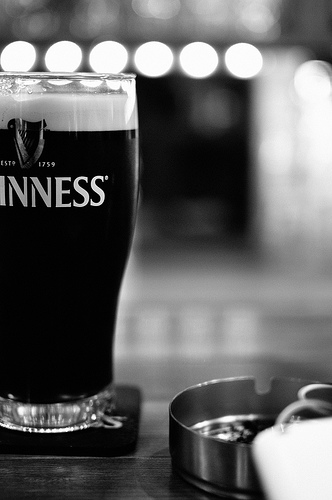You and your friends go out for a few drinks on an idle Friday night. Considering you’re the health nut of the group, they trust you to be the designated driver. You accept your role as chauffeur and take your bros to the bar. But an hour later, the Guinness is going down oh so [...]
 You and your friends go out for a few drinks on an idle Friday night. Considering you’re the health nut of the group, they trust you to be the designated driver. You accept your role as chauffeur and take your bros to the bar.
You and your friends go out for a few drinks on an idle Friday night. Considering you’re the health nut of the group, they trust you to be the designated driver. You accept your role as chauffeur and take your bros to the bar.
But an hour later, the Guinness is going down oh so well. Another hour and the trend continues. And another hour yet and you realize your designated duties are doubtful.
Luckily, you’re coherent enough to notice that Bob only had one drink the entire night. You turn to him, hand him the keys, and then order yourself another drink.
Congratulations.
You just self limited yourself.
Now let’s find out how this applies to your training.
WHAT ARE SELF LIMITATIONS?
Self limitations intentionally cut you off from your maximum capabilities. You can self limit a lot of things for a lot of reasons.
- You can self limit to work around injury
- You can self limit to promote recovery
- You can self limit to deload
- You can self limit to prevent injury
- You can self limit to ensure a light training session
Now, self limitations are movement specific. For every exercise, there’s an absolute maximum performance capacity that represents total potential.
So say you’re looking to pull a maximum deadlift. You would probably:
- Drink strong black coffee
- Wear something that makes you feel awesome
- Get a lot of rest
- Pinpoint your nutrition
- Use a foot stance and grip that allowed for lifting the most weight
- Use footwear you are familiar with
- Use a familiar warm-up strategy
- Use your favorite barbell in the gym
This list can go on forever, and is transferable to different activities. Consider you maximum performance capacity as “aligning the stars,” so to speak.
WHY USE SELF LIMITATIONS?
Self limitations intentionally prevent maximum performance capacity. Back to the deadlift example: If for some reason you didn’t want to try a maximal pull (stiff hamstring, sub-par sleep, etc…), you would likely opt for a “light” day.
But “light” days often turn into “heavy” days despite noble intentions.
I’ve concluded that when I’m on the schedule for conventional deadlifs, I’m going to do damage. So for me, there’s no such thing as a “light” day of conventional deadlifts.
But there are days when I would rather not destroy myself and still conventional deadlift. Here are some ways I could limit myself:
- Don’t listen to music
No music? Good luck getting mentally jacked. You would be surprised how much of an edge Disarmonia Mundi can give a person.
- Don’t drink coffee
Blasphemy.
- Use only the 45 pound plates
You have to be confident in your ability to jump 90 pounds. Smaller jumps can convince yourself that you’re ready to pull something significant even though you might not be. The jump from 135 to 225 is one thing. 225 to 315 is another. 315 to 405 gets murky. Anything above that, and you’re probably experienced enough to tackle this yourself.
- Change the movement (same but different)
Opt to pull with a wider grip, which will stress the upper back and grip. Expose the weak links to reduce the total amount of weight that can be lifted.
YOU NEED TO BE CAREFUL
 Self limitations sound great, but there is a hitch. Usually, by confining an exercise, you’re going to shift the stress to different muscles.
Self limitations sound great, but there is a hitch. Usually, by confining an exercise, you’re going to shift the stress to different muscles.
So while overall systematic stress is reduced, specific stress to certain muscle groups may increase.
In the case of opting to pull with a wider grip, the upper back, glutes, and hamstrings will be stressed in an entirely different way.
Likewise, opting to do power cleans instead of deadlifts presents a unique variation in the stressor. You’re moving faster, which causes a different hit to the body.
Ideally, you want to self limit with something you’re familiar with. So if you do snatch grip pulls regularly, they are a perfect substitute if you’re feeling like trash on conventional deadlift day. And you won’t accidently turn a light session into a max session (at least, from an absolute potential standpoint), which is all too common.
SELF LIMITATIONS ARE MORE THAN LIFTING
Self limitations apply to all training methods. If you’re running, go barefoot and only breathe through your nose.
But the same side effects apply. You’re going to reduce overall system stress, but you will increase the stress throughout the foot. Again, it’s best to choose something that you body is already adapted to.
SELF LIMIT TO SAVE THE LEGS
Another great self limiter is switching exclusively to front squats if you want to keep the legs a little fresher. The bad thing about front squats is that the upper back is usually the first thing to poop out, making back squats an all around superior leg exercise from an absolute loading standpoint.
But if you don’t want expose them to that kind of stress, front squats automatically reduce the burden. The quads will be hit a bit more by virtue of body position, but it won’t be as huge of a hit to the system as a whole.
HOW I SELF LIMIT
My foot is going through a nasty streak of nerve pain. My left hamstring hates me. Too many aerials. (Speaking of which, be sure to check out this post // Why Stretching Won’t Heal an Injury Correctly // over at Trick Training about injuries.) Things are “rough” right now—a killer considering the weather has been beautiful. I’m talking 100 degree heat kind of beautiful—the kind of stuff that drives people inside.
But I hate being cooped up inside as my intestines rot away, even if the heat is rather intolerable to the modern air conditioned coddled civilization. (Actually, I love training in that kind of heat.) But between my foot and hamstring, getting out there to trick, lift, and train is tough.
Now, I do, of course. But only because I know how to use self limitations. Here’s a glimpse of some changes I’ve made:
- Replaced back squatting with front squatting– less loading on bad foot while still allowing me to train legs
- Placed more emphasis on the deadlift over the squat as teetering out of a rack is bothersome to my foot
- Shifted from power cleans to Romanian deadlifts – giving my hamstrings some slow and blood flushing work
- Limited my tricks to everything but aerials – nothing else aggravates the injury, so why stop?
- Incorporated more pull-ups than rows to keep the lower back fresher for more pulling from the floor
NON-LIMITED CONCLUSIONS
If you think I’m getting rid of my coffee and my metal, you’re out of your mind. But I still limit my performance in ways that allows me to continually progress.
Self limitations, in a sense, are responsible for most of my progress. It’s rare to be 100% fresh 100% of the time. Find ways to overcome and train no matter the circumstance.
As they say, the most important part of life is showing up. Self limitations help you do just that. So they’re kind of a big deal.
+++++
There’s a good chance you’re using self limitations now without knowing it. Let me know how in the comments below. I’m interested to hear how you attack this issue. I’m always interested in new ideas!
photo credit: [cipher]
photo credit: Sharon Drummond